Survey of Administrators Regarding the Use of the Voter Information Card as Proof of Address
2. Survey Results
2.1 Respondent Involvement
Responses to the survey were largely provided by those with some authority on the issue (i.e., in charge of coordinating polling activities in their facility). Seven in ten respondents (70 per cent) held the same position or responsibilities as in the previous general election held in October 2008. Just over half (56 per cent) of these respondents were authorized to sign and issue letters of attestation of residence.Footnote 1
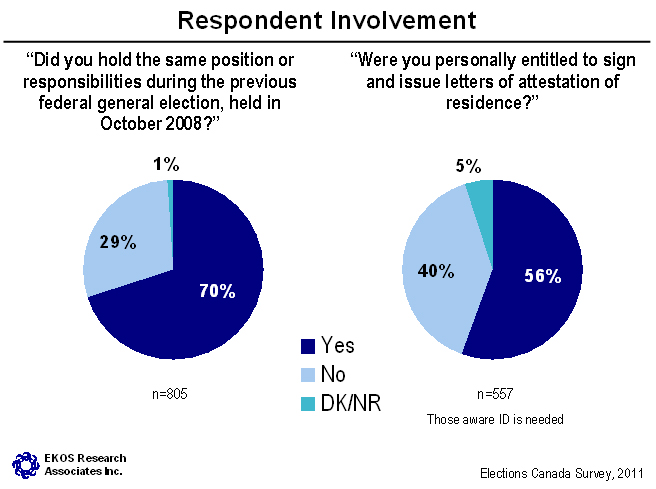
text description of graph "Respondent Involvement"
- Those responding from First Nations reserves were less likely to have had previous experience during the 2008 general election, although one in three did (35 per cent had previous experience, versus 70 per cent overall).
- Compared to the national average, respondents in New Brunswick were more likely to have held the same position they held in the 2008 general election (89 per cent).
- Respondents from facilities in Ontario were more likely to have had the authority to sign letters of attestation (64 per cent).
- Respondents in Quebec and New Brunswick were less likely to have had this authority (42 and 37 per cent, respectively), compared to the national average.
2.2 Awareness of Voter ID Requirements
Virtually all respondents in the survey (99 per cent) said that they were familiar with the requirement that electors must prove their identity and address in order to vote in a federal election. Familiarity with the potential to use letters of attestation of residence as valid proof of address for voting was a lesser known fact, although the majority of respondents (70 per cent) were aware of it. A full three in ten (30 per cent), however, said that they did not know about this.
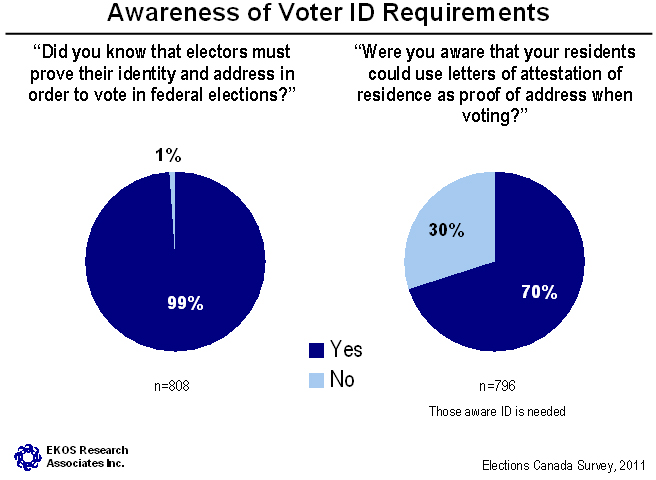
text description of graph "Awareness of Voter ID Requirements"
- Awareness that letters of attestation could be used was lower among smaller long term care facilities (e.g., with fewer than 60 electors) at 58 per cent, compared to 79 per cent of larger LTCF (e.g., with 60 or more electors).
- Awareness of letters of attestation was lower among respondents in Saskatchewan (58 per cent) and higher among those in Ontario (77 per cent) compared to the national average (70 per cent).
For most respondents, their awareness that letters of attestation of residence could be used to prove identity and address was based on information received from Elections Canada generally, although more than half (55 per cent) were not able to identify the exact source at Elections Canada from which they obtained this information. Nearly one in five (18 per cent), however, did identify the Returning Officer as the source of this information. One in ten (12 per cent) obtained this information from Elections Canada document, like a brochure, leaflet or EC website. Another one in ten (12 per cent) indicated that they were already aware of this provision, having had previous experience with federal elections.
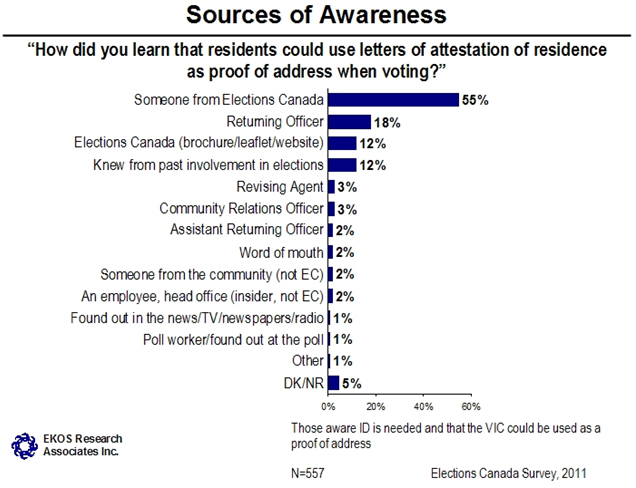
text description of graph "Sources of Awareness"
- Compared to the national average, respondents in Saskatchewan were more likely to have identified the Returning Officer as their source of information for the letter of attestation of residence (41 per cent). Respondents in Ontario were more likely to have heard the information from someone (unidentified) from Elections Canada (63 per cent). Those in British Columbia/Territories were more likely to have known about it from involvement in a previous election (20 per cent).
2.3 Awareness of Use of Voter Information Cards (VIC)
Most respondents (73 per cent) were aware that electors living at their location could use a voter information card as proof of their identity and address. Once again, information about this provision was usually heard from someone from Elections Canada (44 per cent of respondents). One in ten (10 per cent) identified the Returning Officer as the source of this information. One in five (19 per cent) said they knew about this from information printed on the VIC itself. One in seven (13 per cent) learned about it from an Elections Canada brochure, website or leaflet. One in ten (10 per cent) were unsure where they got this information.
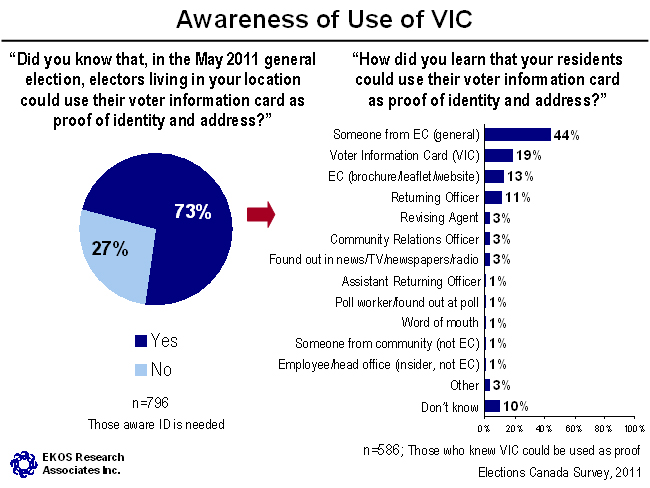
text description of graph "Awareness of Use of VIC"
- Those who were in the same position in 2008 were more likely to report the Voter Information Card as the source of information (22 per cent, versus 13 per cent of those who did not hold the same position as in 2008).
- Compared to the national average, respondents in Manitoba were more likely t to have learned about this through someone (unidentified) at Elections Canada (66 per cent versus 44 per cent overall). Respondents in Alberta were more likely to have learned about this through the Voter Information Card itself (36 per cent compared to 19 per cent overall).
2.4 Level of Satisfaction with Information Provided
Virtually everyone who reported that they received their information from an Elections Canada official (i.e., Returning Officer, Assistant Returning Officer, Revising Agent, CRO, or an official generally) was at least somewhat satisfied with the information they received. More than seven in ten (71 per cent) were very satisfied and another quarter (25 per cent) were somewhat satisfied.
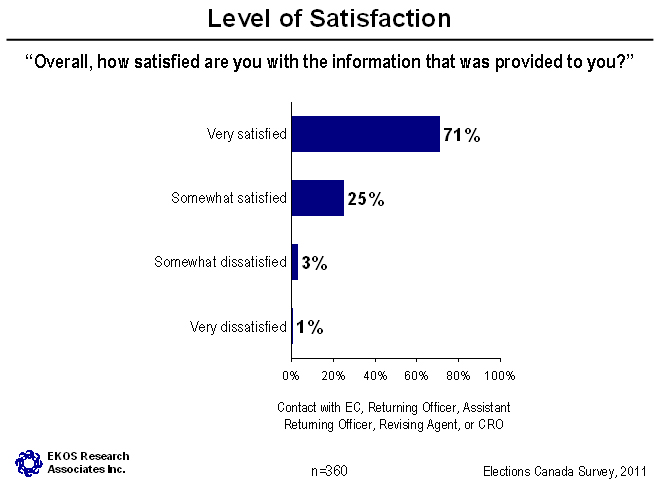
text description of graph "Level of Satisfaction"
Of those who were aware that identification was needed in order to vote, almost three in five (58 per cent) said that they received information from Elections Canada regarding voter identification requirements. One in three said that they did not receive such information (34 per cent).
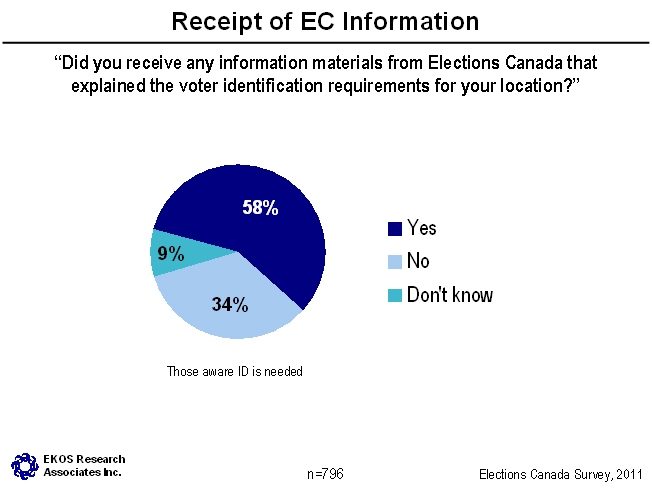
text description of graph "Receipt of EC Information"
- Respondents who knew they were authorized to sign letters of attestation were more likely to report that they had received information materials about voter identification requirements (67 per cent compared with 59 per cent among those who did not have such authority). It is also interesting to see that the awareness of the potential to use letters of attestation of residence as proof of identity is higher among those who said that they had received information materials, although not everyone who said they had received information materials reported being aware that letters could be used in this way.
- Respondents from First Nations Band Offices were among the most likely to say that they received information materials (78 per cent, compared to 58 overall). Respondents in smaller long term care facilities (i.e., with fewer than 60 residents) were the least likely to report that they received such information (50 per cent).
- Respondents from facilities in Quebec and New Brunswick were more likely than the overall average to report not getting any information materials explaining the voter identification requirements (50 per cent each, compared to 34 per cent overall who did not receive information materials).
2.5 Letters of Attestation of Residence
Of respondents who were authorized to sign letters of attestation of residence (n=310), fewer than half say their organization issued any letters for residents (45 per cent). Nearly the same proportion (44 per cent) reported that their organization did not issue any letters. Only a small segment of respondents (11 per cent) say their organization issued a large volume of letters (40 or more). The overall average across all respondents was 17 letters issued by their organization. Among only those respondents reporting that their organization had issued any letters, the average was 34.
Relatively few respondents from organizations that issued letters of attestation of residence said that there were any challenges to issuing these letters. One in ten (10 per cent) reported that the task of issuing letters was time consuming and a lot of work. Four per cent said that the lack of information, explanation or instructions made it difficult for them; and an equal proportion said they felt rushed at the last minute. Nearly eight in ten (79 per cent) said that they encountered no problems. Respondents who did not hold the same position in 2011 as they did in 2008 were more likely to have felt challenged by a lack of information or explanation about letters of attestation.
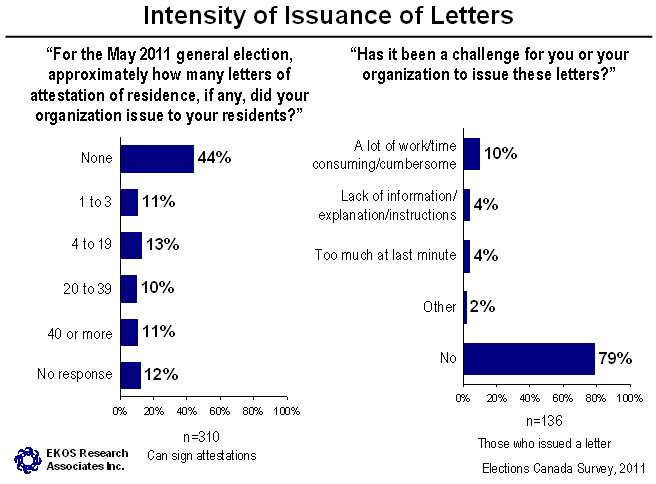
text description of graph "Intensity of Issuance of Letters"
- Where letters of attestation of residence were issued, the average number issued was fewer than five in student residences, eight in seniors' residences, 12 in First Nations Band offices and 21 in long term care facilities..
- Organizations offering both long term care and seniors' residences (typically the largest organizations in the sample) had the highest average with 62 letters per organization among those that issued letters.
- Seniors' residences were the most likely to say that they did not issue any letters (56 per cent compared to 25 to 41 per cent in other types of facilities).
- Respondents in Quebec facilities were more likely to report their organization had issued no letters of attestation (62 per cent compared to 44 per cent across Canada).
2.6 Contact with Elections Canada
Those who reported they had obtained information from an Elections Canada official were asked how many times they were contacted by Elections Canada in relation to the May 2011 election. Nearly half (46 per cent) were contacted three or four times. The average number of contacts is four. The average number of contacts is slightly higher in larger long term care/seniors' residences (i.e., those with 60+ residents) and in mixed LTCF/seniors' residences.
The majority of respondents (85 per cent) felt that the volume of contacts from Elections Canada was reasonable. Just one in 10 (nine per cent) said it was too much, and one in 20 (five per cent) felt it was not enough. Those who encountered problems during the 2011 election are more likely to have had a higher number of contacts with Elections Canada (five or more times). They are also more likely to have been dissatisfied with the amount of contacts from Elections Canada (i.e., too much or too little).
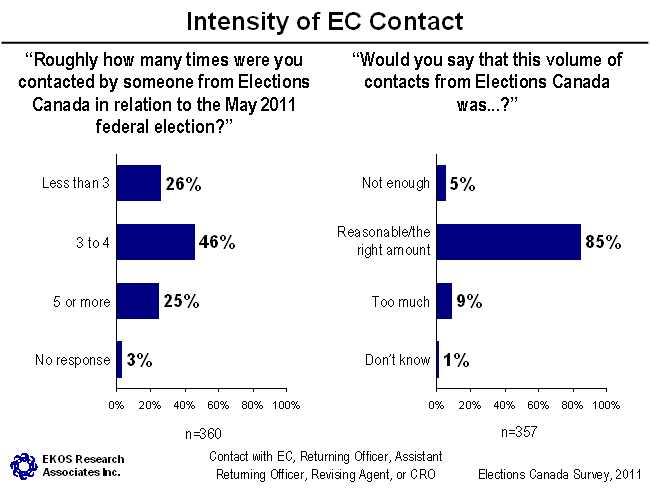
text description of graph "Intensity of EC Contact"
- Respondents in Quebec reported fewer contacts with Elections Canada than respondents in other provinces (38 per cent in Quebec had fewer than three contacts with Elections Canada, compared to 26 per cent overall).
2.7 Voter Identification Requirements
The vast majority of respondents (85 per cent) reported they neither heard nor witnessed any problems encountered by residents at their organization regarding identification requirements. Just seven per cent indicated they knew of someone encountering a problem with identification documents, such as difficulties regarding valid photo identification. Other problems each indicated by two per cent or less included:
- Problems with the voters list (e.g., not registered, deceased elector);
- Too stringent identification requirements for administrators (causing logistical problems);
- Voter information cards that were not received or had errors;
- Problems with proof of address;
- Confusion or lack of awareness about being able to use the VIC as identification.
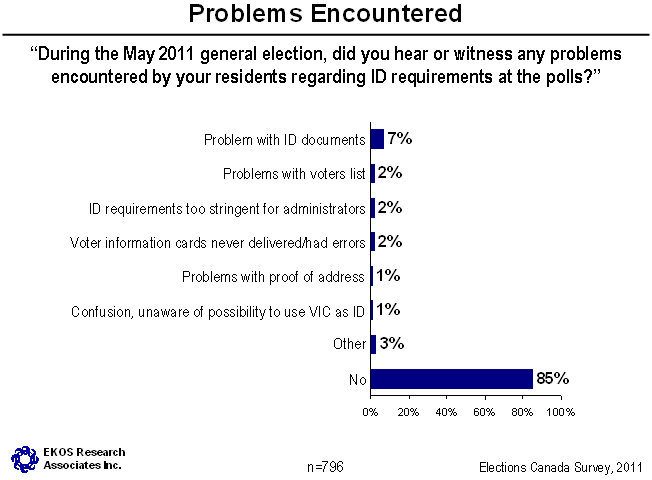
text description of graph "Problems Encountered"
- Respondents who worked at a First Nations site were somewhat more likely to report knowing of problems encountered with identification documents (15 per cent versus seven per cent overall).
- Those from larger organizations (e.g., 100 electors or more) were somewhat more likely to report knowing of problems encountered with identification documents (11 per cent, compared to five per cent of smaller organizations).
- Those reporting problems during the 2011 election were less satisfied than others with the information they received (98 per cent compared with 85 per cent among those who did not report problems).
2.8 Impact of VIC on Voting Process
Respondents holding the same position in 2011 as they had in 2008 were asked to compare their experiences with voter identification, in light of the fact that Voter Information Cards were accepted as proof of identity and residence in 2011. Most felt this new measure made the voting process easier for residents compared to the 2008 general election. Almost two-thirds (64 per cent) said that the process was easier (26 per cent) or a lot easier in 2011 (38 per cent), and eight per cent felt the process had been made a little bit easier. Still, almost one-quarter (23 per cent) said they did not see any change or thought the process was no easier.
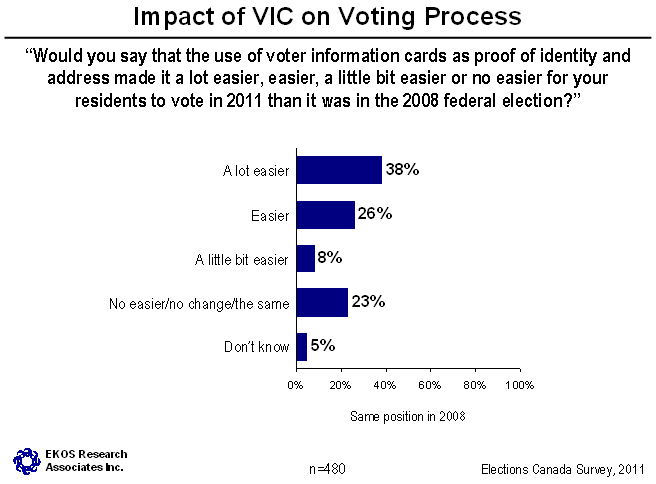
text description of graph "Impact of VIC on Voting Process"
- Those who reported no problems in the 2011 election were more likely to have felt that the acceptance of the VIC had made the process a lot easier (40 per cent, compared to 25 per cent who had encountered problems).
- Respondents who were not authorized to sign letters of attestation of residence were more likely to have felt that the acceptance of the VIC had made the process easier (33 per cent, compared to 25 per cent of those who were responsible for issuing letters).
- Respondents from facilities in Alberta were less likely to report an improvement (36 per cent said that it was no easier in 2011, compared with the overall sample average of 23 per cent).
- An improvement to the process also seems less likely to have been felt among respondents from large seniors' residences and LTCF (e.g., 60 and more electors) where respondents were more likely to say there had been no change in ease of the voting process (30 per cent, versus 23 per cent of respondents at smaller facilities).
2.9 Contact with Community Relations Officer or Revising Agent
A small number of organizations (n=45) reported having used the services of an Elections Canada Community Relations Officer (CRO) or Revising Agent (RA). Almost all of them (96 per cent) said the services they received facilitated the voting process. Most (71 per cent) also obtained information materials from these officials. Translation services, information sessions and information kiosks were other services that these officials were able to provide to respondents. All of the organizations receiving these services were at least somewhat satisfied, most (78 per cent) being very satisfied. The most satisfied were those likely to have used the information kiosk, information sessions or information materials (although numbers of cases using each service are quite small and these results are only directional at best).

text description of graph "Use of CRO/RA Services"
2.10 Suggestions for Improvement
Few respondents expressed additional concerns or suggestions for areas of improvement. But when they did, their suggestions varied widely between specific problems (13 per cent) and specific suggestions for changes in the future (32 per cent). Most commonly expressed concerns are that ID requirements should be simplified further; better training of poll workers and preparation by Elections Canada is needed; and more information about identification requirements and the voting process is needed. These suggestions, however, were each made by relatively small proportions of responding organizations (i.e., three to eight per cent). Most respondents offered no other suggestions, or reiterated their satisfaction with the experience and the improvement to the voting process. Seven per cent reiterated that their experience had been mostly positive or that accepting the VIC had improved the process.
| Suggestions | % |
|---|---|
| Future Improvements | 32 |
| ID requirement in institutional environment need to be further simplified | 8 |
| Require better preparation/planning from EC or better training for poll workers | 5 |
| Good experience overall | 5 |
| Require more or better information about voter ID requirements and voting process, including posters | 3 |
| Accepting voter information cards improved the process | 3 |
| Using lists of residents would be better than issuing individual letters of attestation or relying on voter information cards | 3 |
| Require earlier contact or notification to allow better planning | 2 |
| More assistance needed at the polls, more flexibility in who can assist | 1 |
| Too demanding for local administrators | 1 |
| Voting by special needs requires more flexibility (such as the possibility to vote anywhere, send mobile polls at home) | 1 |
| Specific Problems Encountered | 13 |
| List of electors was inaccurate, problems with reception of voter information cards | 3 |
| Received conflicting or ineffective information from EC, info sent to or contact made with wrong persons | 3 |
| Impaired electors remain problematic, some are just not able to vote | 3 |
| Mobile polls not present for long enough, or came at a wrong time | 2 |
| Addresses on the VIC should have included suite numbers or are being sent at home (VICs should be sent directly to residents) | 1 |
| Dealings with EC involved privacy issues | 1 |
| No suggestions | 52 |
| Other | 3 |
n=808; 387 had suggestions.
Footnote
Return to source of Footnote 1 Attestations of residence are letters signed by an authorized representative in order to prove where residents live.
